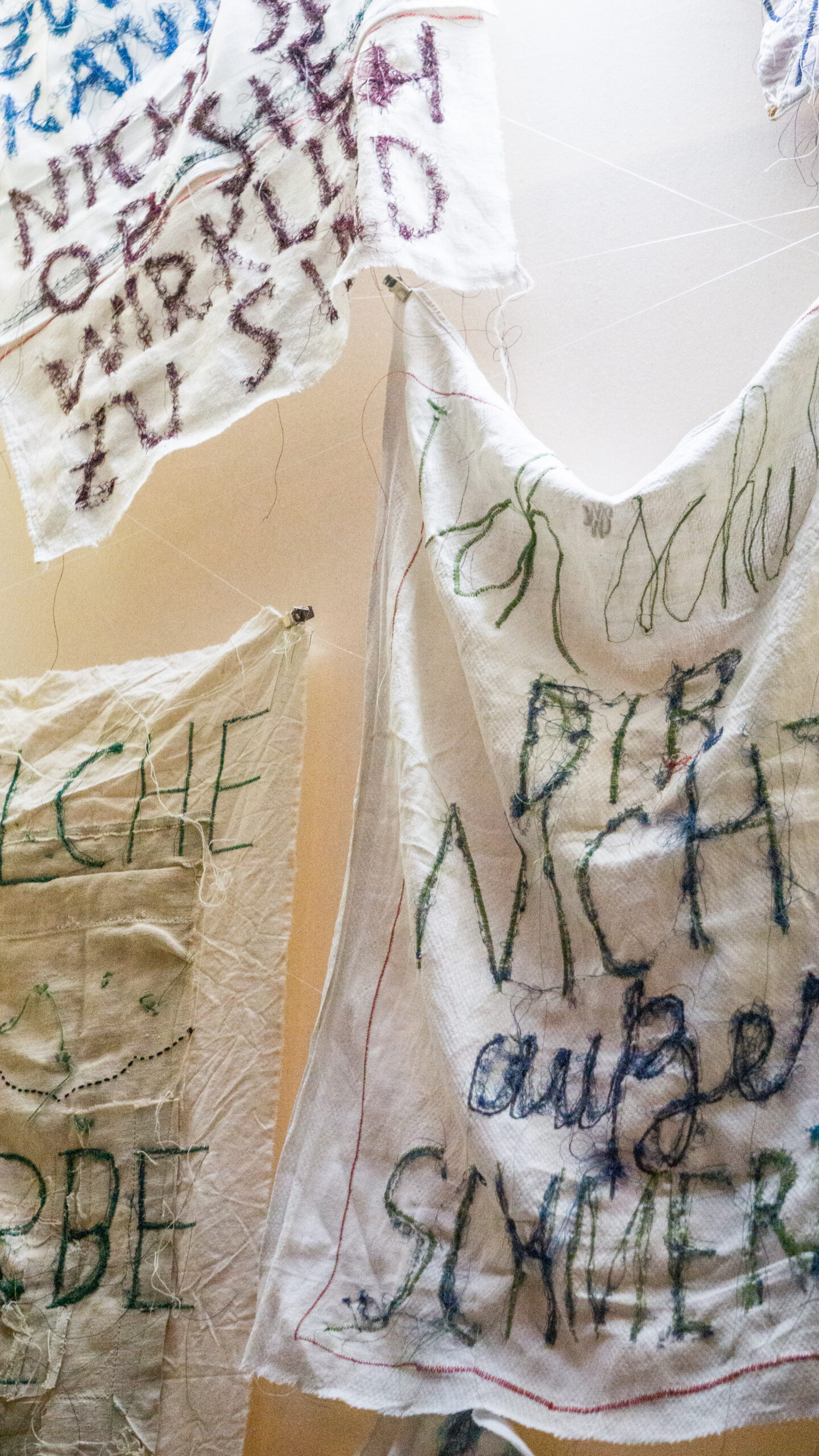May 2023 - November 2023
Allison Honeycutt
Flesh Suits, 2023
latex, acrylic paint, synthetic wig segments, fiber
The works of the US-American artist Allison Honeycutt circulate around themes such as shame and nudity, the staging of beauty ideals and the question of who or what is considered beautiful. What is nudity? When is nudity irritating? When is it inappropriate?
On the one hand, the Flesh Suits consist of the objects bra and panties, but at the same time they also show explicitly physical things, such as pubic hair and nipples. Instead of covering up, they present sexually connoted areas of the body.
The exaggerated intimate hair, reminiscent of a wig, lends the ensemble an ironic component. About her work, the artist says, "My intention is never to offend or shock, but to make viewers more open to nudity by looking at it with humor and curiosity."

Faiqa Sultani
Bag (silver), 2022
There is no sign of life I don’t receive any signs from you – Poet: Rumi; acrylic and glass paint, cotton, polyester,
Bag (gold/blue), 2022
I am who I am; acrylic and glass paint, cotton
Scarf (white), 2022
Being human is a dream – Poet: Rumi; polyester, embroidered
Scarf (red), 2022
You make me life and world / What can I do to make life and the world – Poet: Rumi; acrylic and glass paint, polyester
The Afghan artist Faiqa Sultani dedicates her textile works to Persian poetry. Calligraphy, the art of writing, was historically important in Afghanistan and Iran and is still cultivated today by artists in the diaspora and translated into new creative processes. For her works, Faiqa Sultani combines this long-standing art form with textiles in everyday form, such as bags and garments. She writes quotes from poems by Forugh Farrochzád and Rumi in Dari on the textiles, creating wearable poetic statements.
In addition to these, she also deals with the everyday life of women in her home country in her figurative paintings and thus draws attention to the political situation in Afghanistan here in Germany since 2022.
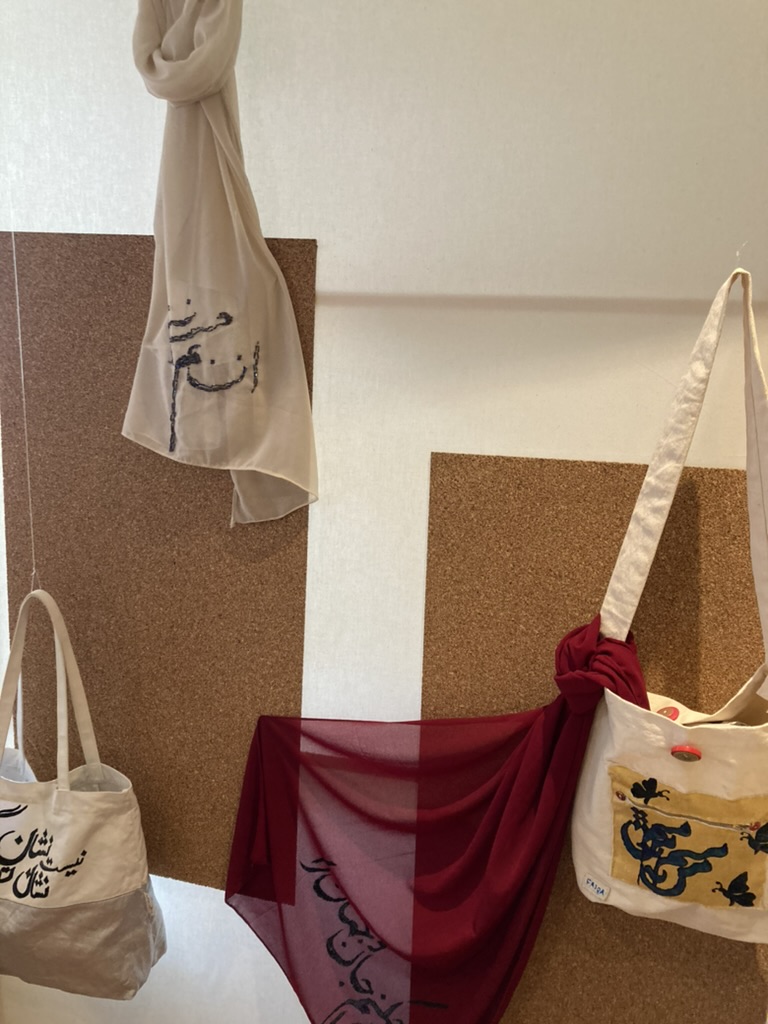
Jessi Strixner
Menstruation Pantie, 2023
lime, acrylic
Wet Pantie, 2020
lime, acrylic, lacquer
Munich-based wood sculptor Jessi Strixner takes us to a limit with the question of what textile art is: she deceptively recreates the textile out of wood; she also stages the carelessly removed briefs.
The artist's oeuvre includes not only the reproduction of various items of clothing such as jackets, socks and underwear, but also other everyday objects such as post-its and banana peels. Through detailed depiction of form and haptics, Strixner creates new irritating impressions that encourage a closer look. Only at second glance do they reveal wood as their material.
With the series No More Taboos, the artist adds panties with menstrual blood and vaginal discharge to her series of everyday objects, with the intention of viewing them as just that and no longer making them taboo.
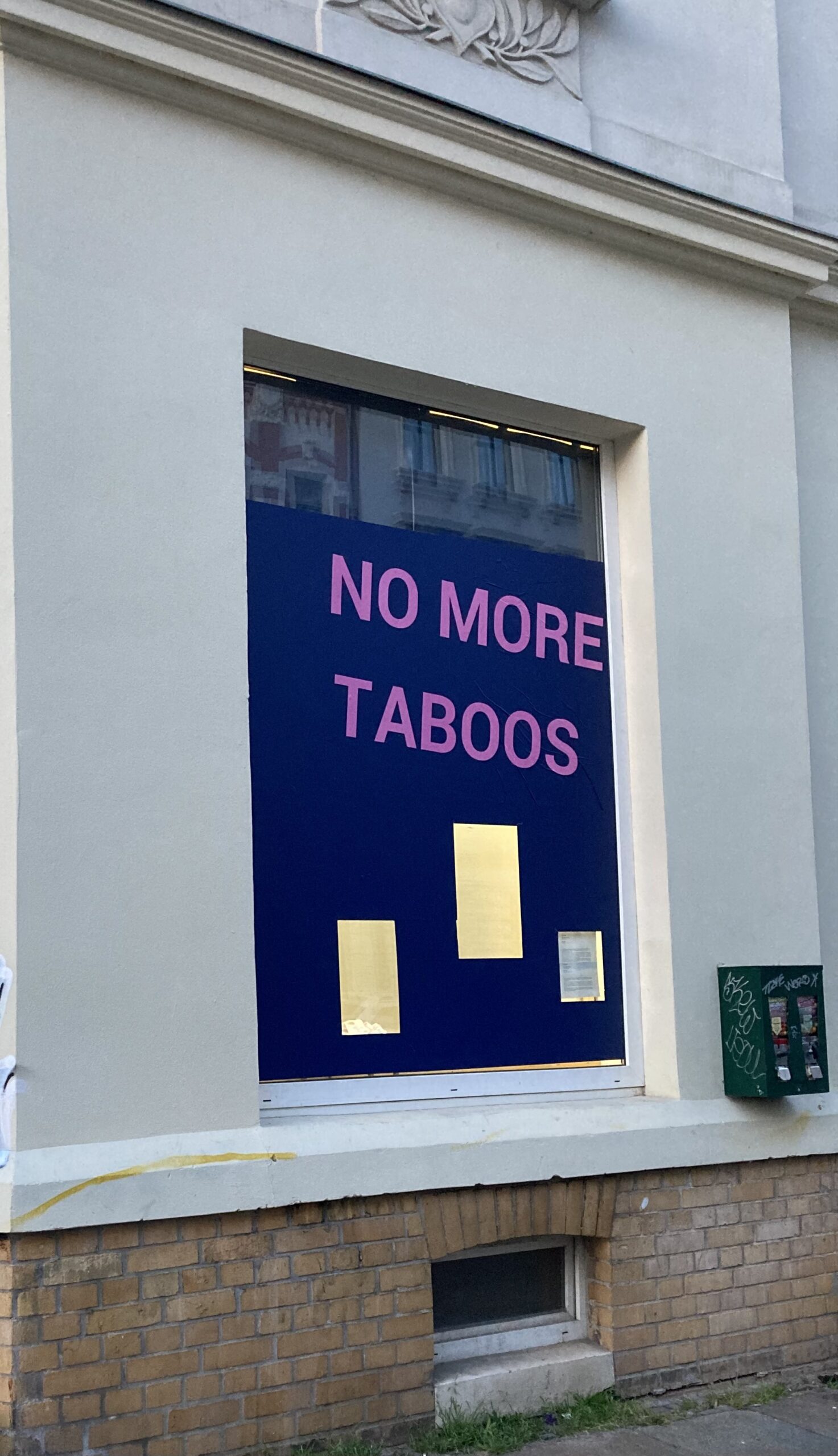
Gülbin Ünlü
dÜstopia, 2021 (Incorporated; Waiting for human extinction; Organised confusion)
canvas, ink
In a technique developed specifically for her work dÜstopia, the Munich-based artist materially combines painting and printing. She applies liquid ink to wet canvases, creating a hybrid painting. The form and presentation of this painting, a cape reminiscent of shirts, translates it into the context of fashion. In terms of content, the artist deals with the commercialization of all areas of society. Her painting becomes a product itself in the form of the oversized T-shirt and shows symbols of various social movements, which thus appear like logos of brands. Where does a product begin, how can a brand be defined, and what happens to personalities in social media? Gülbin Ünlü raises these questions with her performative work. In it, the shirts were worn by artists in a kind of procession through downtown Munich, and past fashion stores.
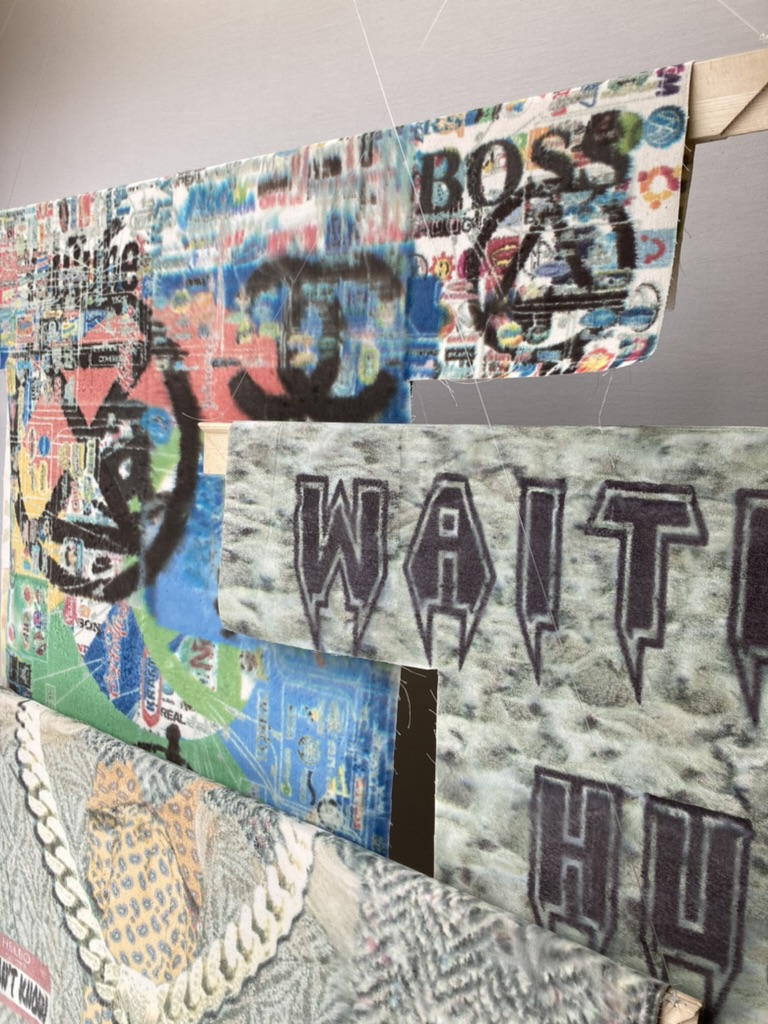
November 2022 - May 2023
Aline Schwibbe
Fearless Flowers (I Move Through Chicago Like Honey), 2018
Graphite, oil, oil pastel and pen on textile
back in heels, 2022
digital print, oil stick and pastel on velvet
hips, 2022
digital print, oil stick and pastel on velvet
In her artistic practice, Aline Schwibbe repeatedly devotes herself to textile materials and combines them with her own graphics, paintings and video works. Questions of accessibility to social spaces and participation in society run through her work. Schwibbe adopts a feminist perspective.
In her 2018 work "Fearless Flowers (I Move Through Chicago Like Honey)", the artist works with a familiar clothing cut: the blazer. Known from menswear, the jacket is equally worn by women, and to this day connotations of formal dress cling to it: the trouser suit as a symbol of women‘s strength and assertiveness (also) at work.
Aline Schwibbe deliberately chooses seemingly neutral white blazers for her work, which she paints with black and gold oil pastels and graphite. The associative imagery on the clothing, which shows footprints, for example, conveys testimonies of presence or, through subtle references to security checks at airports, establishes a connection to the recurring question of access. Access and cohesion are also represented through the sculptural treatment of the blazers. Cut in half, the blazers are tied together with loops on the arms at wrist level. In this way, the artist forms an image of the bond between women who unite shoulder to shoulder and strengthen each other. A significant image for Aline Schwibbe, especially in art and cultural work.
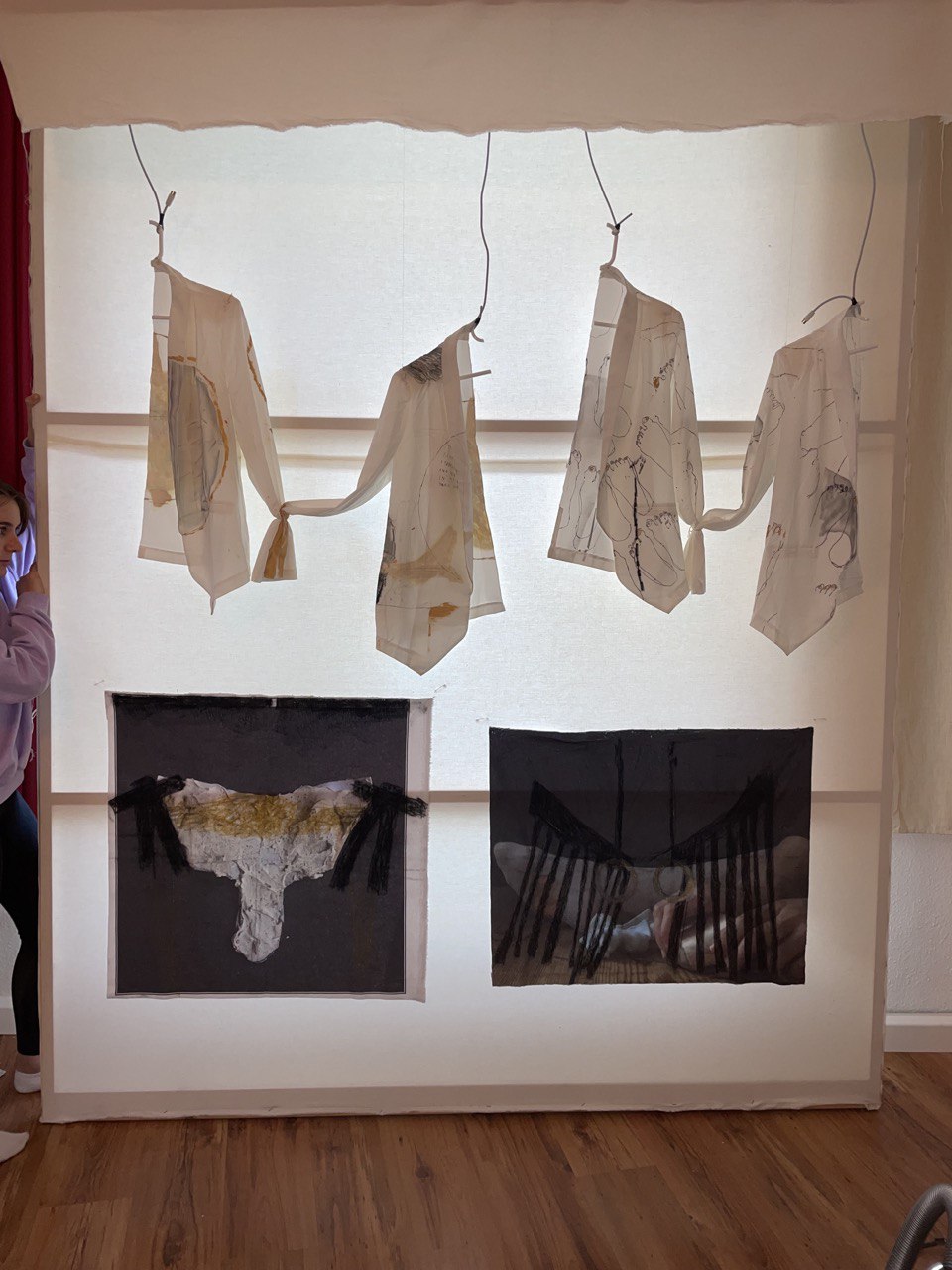
Susan Hensel
Toxic Nostalgia, n.d.
muslin, antique lace, rust
The multimedia artist Susan Hensel combines a variation of textile techniques in her œuvre. Amongst other things, she works with historic lace embroidery, and also with state-of-the-art computer technology for her often intensely-coloured works, which also exist as installation pieces.
For Toxic Nostalgia, the artist combines white historic lace fabrics reminiscent of worn and sometimes torn garments. The traces of time that appear on the fabric, yellowed by rust, make it clear to the viewer how memories of the wearer can also be inscribed in the textiles. These can be joyful and positive, but also involve traces of painful experien- ces. The artist initially inscribes invisible messages into the light muslin with the histori- cally known lace, which is associated with female craftsmanship. Only through UV light directed specifically at the fabrics can the viewers recognize the statements like weak, hysterical or don ́t worry your pretty little head.
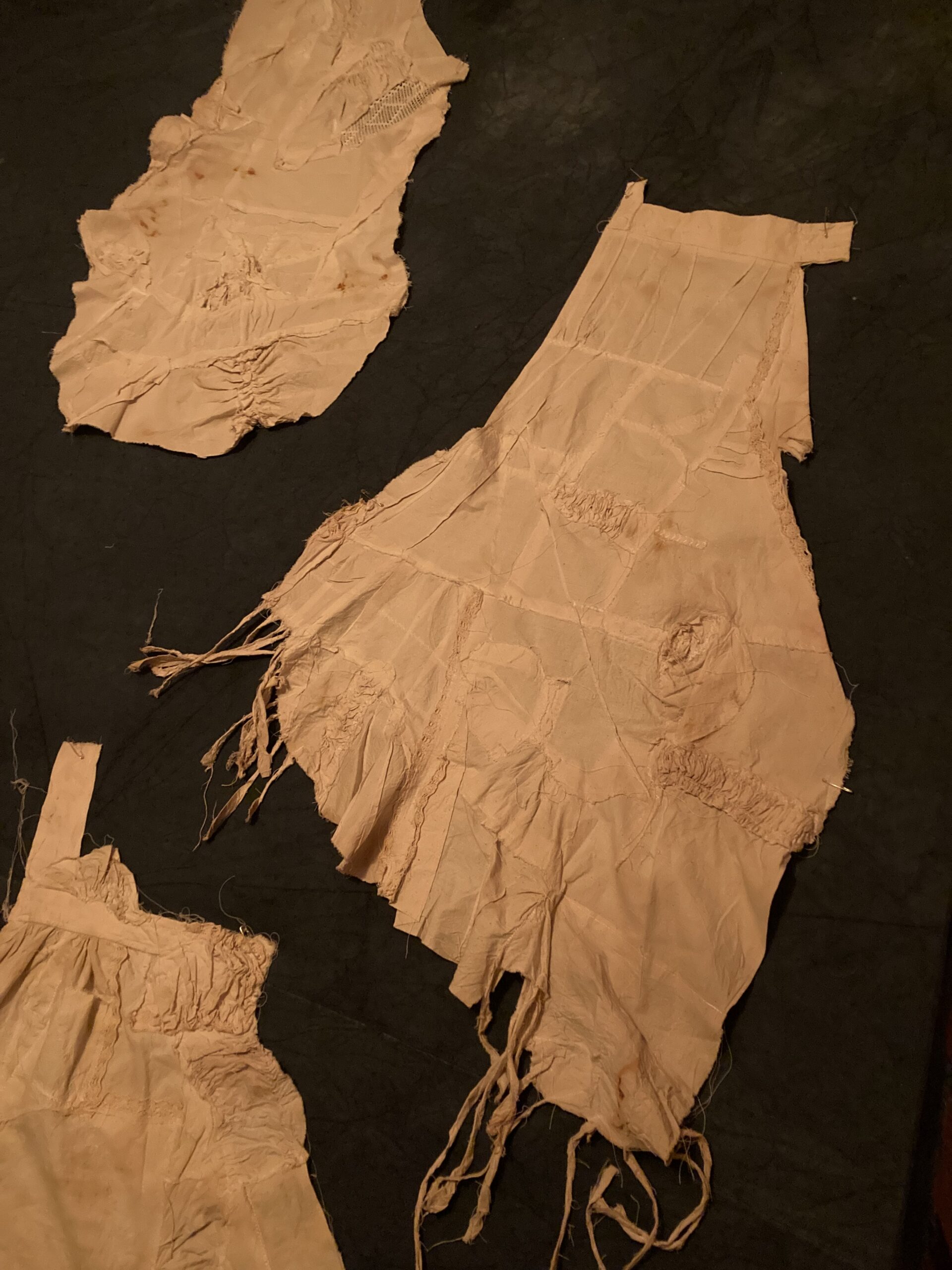
Sophia Louise Roggenkamp
self-doubt fan scarf, 2021
100% polyacrylic, knitted
new, 2022
various yarns, tufted
Am I an artist? I‘m an artist. Am I an artist? I‘m an artist. Am I an artist? I‘m an artist. Am I an artist? I‘m an artist.
In her work self-doubt fan scarf, the Halle-based artist Sophia Louise Roggenkamp explores the artistic self. Who is actually an artist – is self-perception or social reception the decisive factor? In finding the answer, the wearers and seekers cheer themselves on with the aid of their fan scarf.
In true Pop Art manner, Sophia Louise Roggenkamp uses the keywords of consumer culture such as new and now; in other works also sale and offer, thereby generating attention and directing the viewer‘s gaze to the content of the windows. Only here, the object of desire is the advertising medium. The art becomes an advert for itself and, by proxy, for the artist. Another act of celebrating oneself, of stepping into the public eye and demanding recognition for one‘s own achievements.
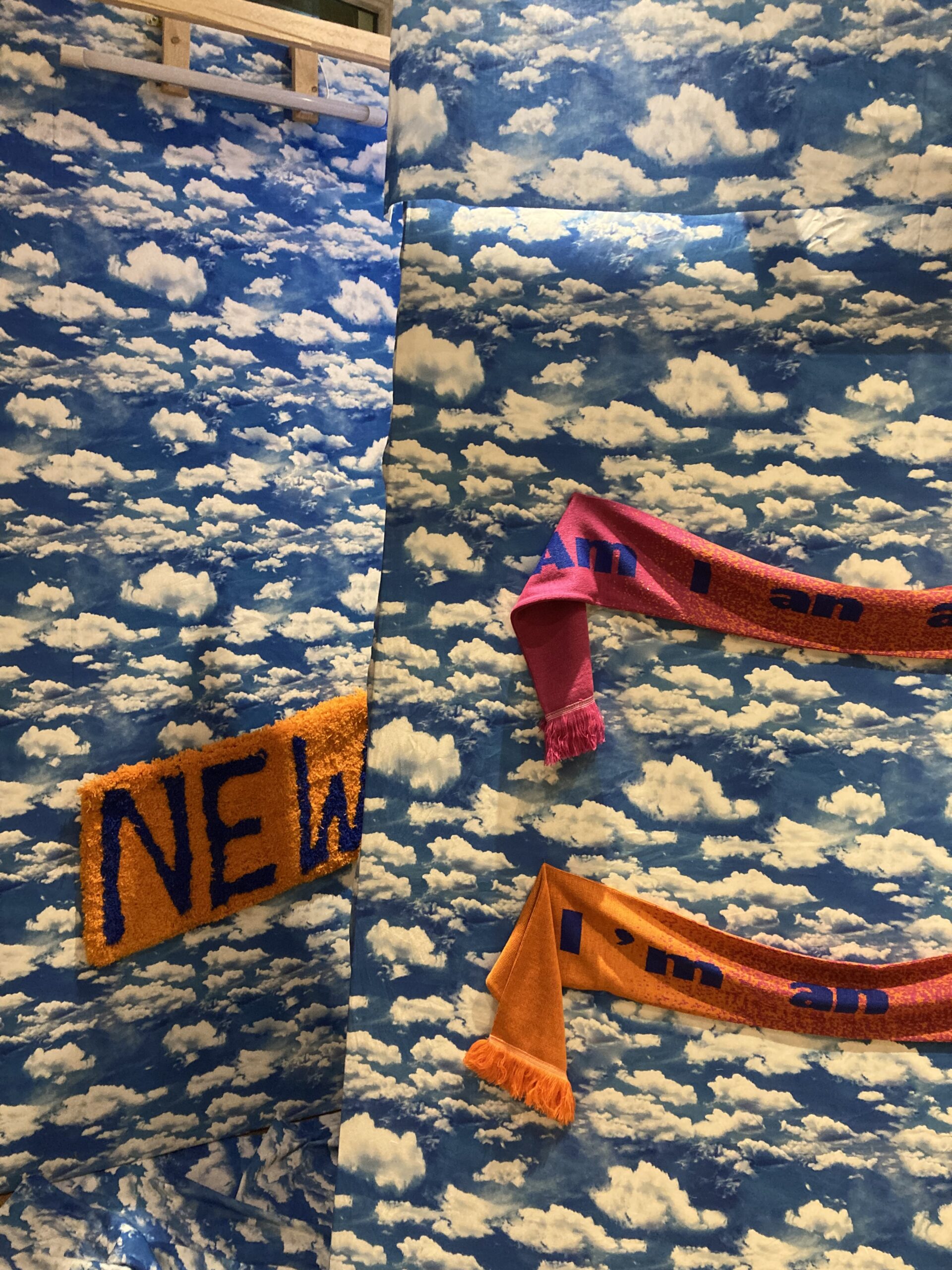
January 2022 - November 2022
Sally Hewett
Fully Fleshed, 2021
stretch net, lycra, padding, quilting hoop
Glorious Asymmetry, 2016
lycra, foam padding, embroidery silk, embroidery hoop
Allergic Reaction, 2019
lycra, padding, embroidery hoop
Putti, 2017
lycra, foam padding, embroidery hoop
Petals, 2017
lycra, nylon, foam padding, embroidery silk, quilting hoop
In her embroidery works, British artist Sally Hewett addresses body realities beyond established ideals of beauty. For Hewett, bodies are archives into which experiences are inscribed. Stretch marks, mastectomies, scars and so-called rolls of flab are not blemishes for the artist, but "marks of life" to be shown and celebrated. The artist superimposes several layers of lycra fabrics in different colours in an embroidery frame to create the various colour tones of the skin. She embroiders these initially two dimensional surfaces and finally fills them with padding material.
Many of Hewett's works show the consequences of medically necessary interventions, which are meant to be made visible as relics of a battle fought against disease.
What influence do social conventions have on one's own perception of the body? Are there attributes that can be objectively described as particularly beautiful or ugly? These are questions that Sally Hewett asks herself in her artistic practice. Body parts after cosmetic surgery also find their way into her works. It is the artist's concern to present real bodies in their diversity and individuality and thus to show socially distorted perceptions of the body.
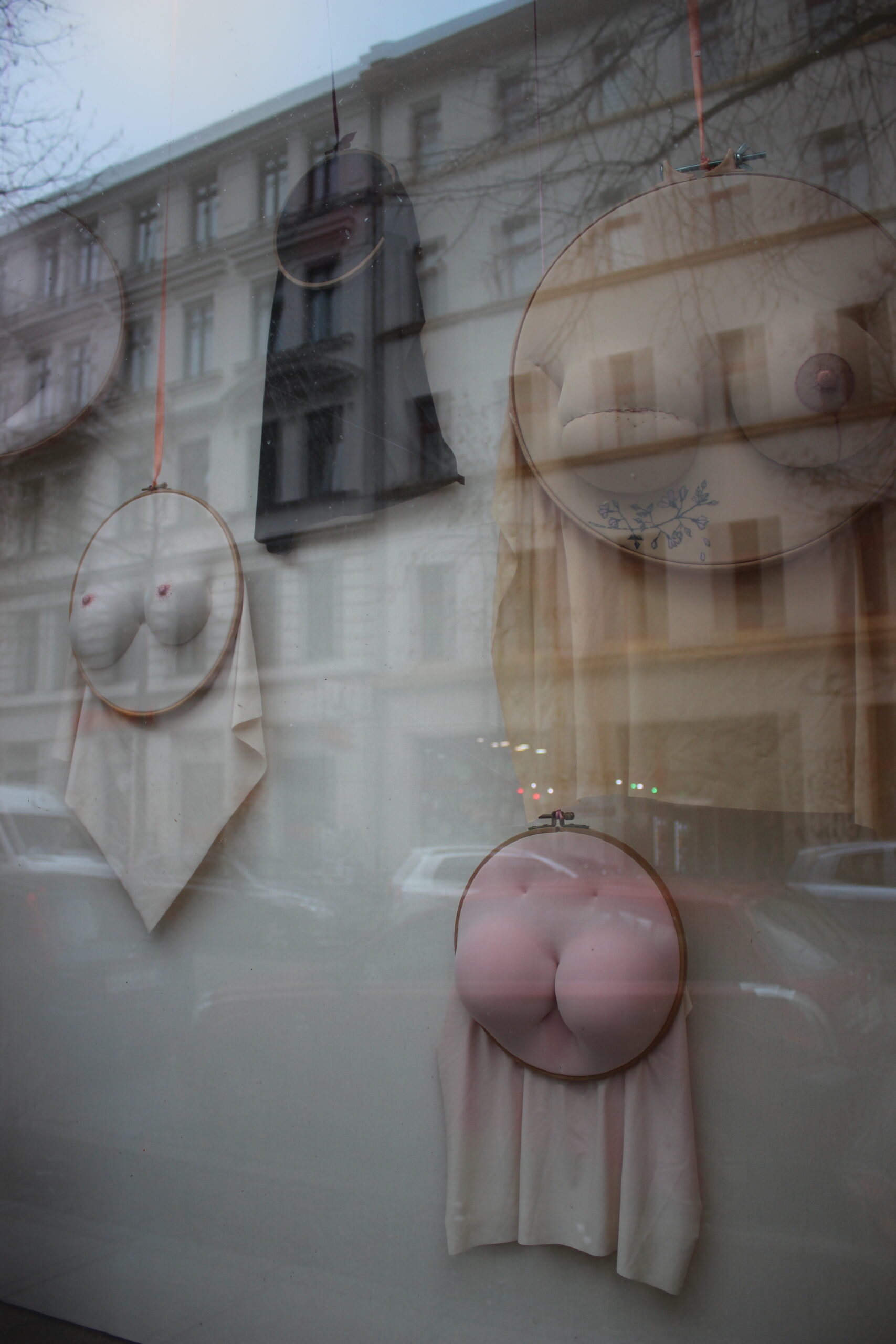
Sarah Schuschkleb
Jasmin, Thekela, Nymphe, Frau Winnetou, Aurora, Wassernixe, Medusa, Fifi, Wallburga, Hektor, Quallery, Captain America, Graf Funkel, Rapunzel, 2013
mixed media
The finger rings by artist Sarah Schuschkleb play with the movements of the wearer. Their long, thread-like structures restrict the functionality of the hand. At the same time, they evoke the desire for new movements, which is followed by the question of how these threads can be moved sensually. It is not clear whether the hand follows the ring or the ring follows the hand.
Sarah Schuschkleb has attributed an individual character to each ring, as can also be seen from their narrative names, for example: Medusa, Rapunzel and Captain America, which are reminiscent of characters in a puppet theatre.
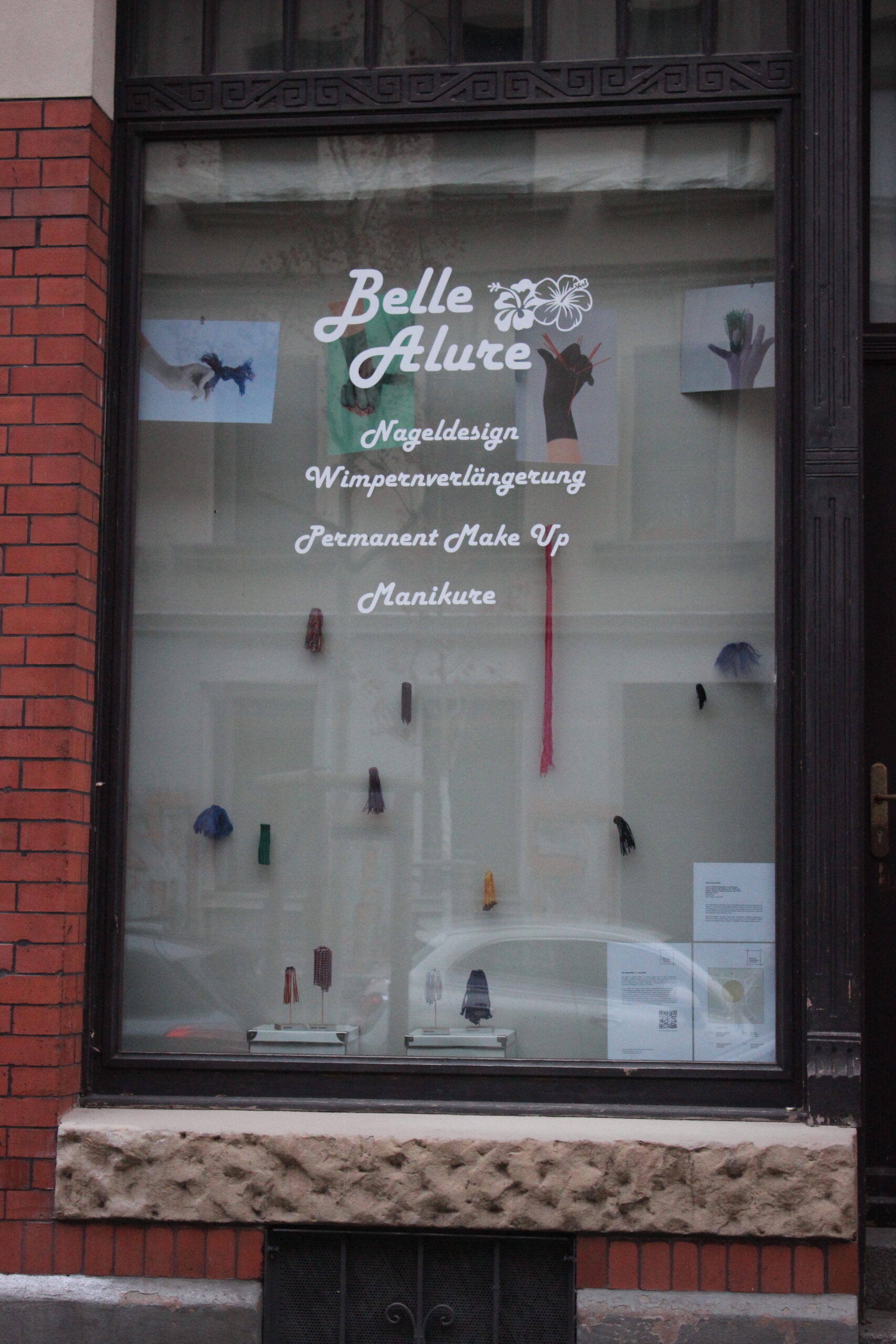
Ulla Stina-Wikander
Iron (from the series "Untitled Set"), n.d.
iron, textile
Designer and visual artist Ulla-Stina Wikander has been collecting cross-stitch embroideries that she found at flea markets and second-hand shops. These half-traditional, half-kitsch textile works, which are usually produced by women, have been used by the artist since 2012 to cover or disguise household objects from the 1970s.
Wikander cuts the fabrics into small pieces and drapes or sews them around objects such as irons, sewing machines or hoovers. With this covering, she changes the haptic qualities of the household appliances from cool metal and plastic objects to soft-looking textile structures. At the same time, she removes their functional character and transforms them into aesthetic exhibits.

Hansinger (Johannes Geitl)
n.t., 2019
polyester felt, foliated
n.t., 2020
Stretch lacquer, quilted
With this stiff-looking and unusual bolero jacket, designer Johannes Geitl has created a garment that barely hints at the human body shape underneath. The shiny fabric enhances body movements by reflecting light. The jacket is part of an eye-catching stage costume that Geitl designed for drag queen Janisha Jones to mark her performance during Superball Amsterdam in 2019. The Superball in Amsterdam is organised in reference to the so-called ball culture of the 1920s in New York. At that time, marginalised homosexual groups organised so-called balls, at which people ran and danced on catwalks for prizes and trophies in different categories.
These events became very popular in the 1990s, not least because of the expressive dance style of vogueing, in which rival performers compete peacefully with each other . Madonna also presented this dance style in her song Vogue and thus spread it in pop culture.
Lacy, ear-like shapes and spikes on an oversized hood surround the head of the person wearing it. Wide sleeves and a wide handle tied at the waist cover the naked upper body and reach just to the upper half of the thighs. With this costume, designer Johannes Geitl takes up the Japanese fan practice of cosplay. This involves fans imitating characters from mangas, video games, anime or other media as faithfully as possible in appearance and behaviour. During these role plays at competitions and other events, gender boundaries are broken down, allowing endless combinations of different characters.
Inspired by a drawing by the American illustrator Zach Brunner, who created the the appearance of a creature from the fantasy world of the Pokémon video games of the 1990s for the human body, Geitl designed the costume from stretch lacquer.
This makes it possible to slip into the role of the Gengar Pokémon, who fights his adversaries using poison and ghostly powers.
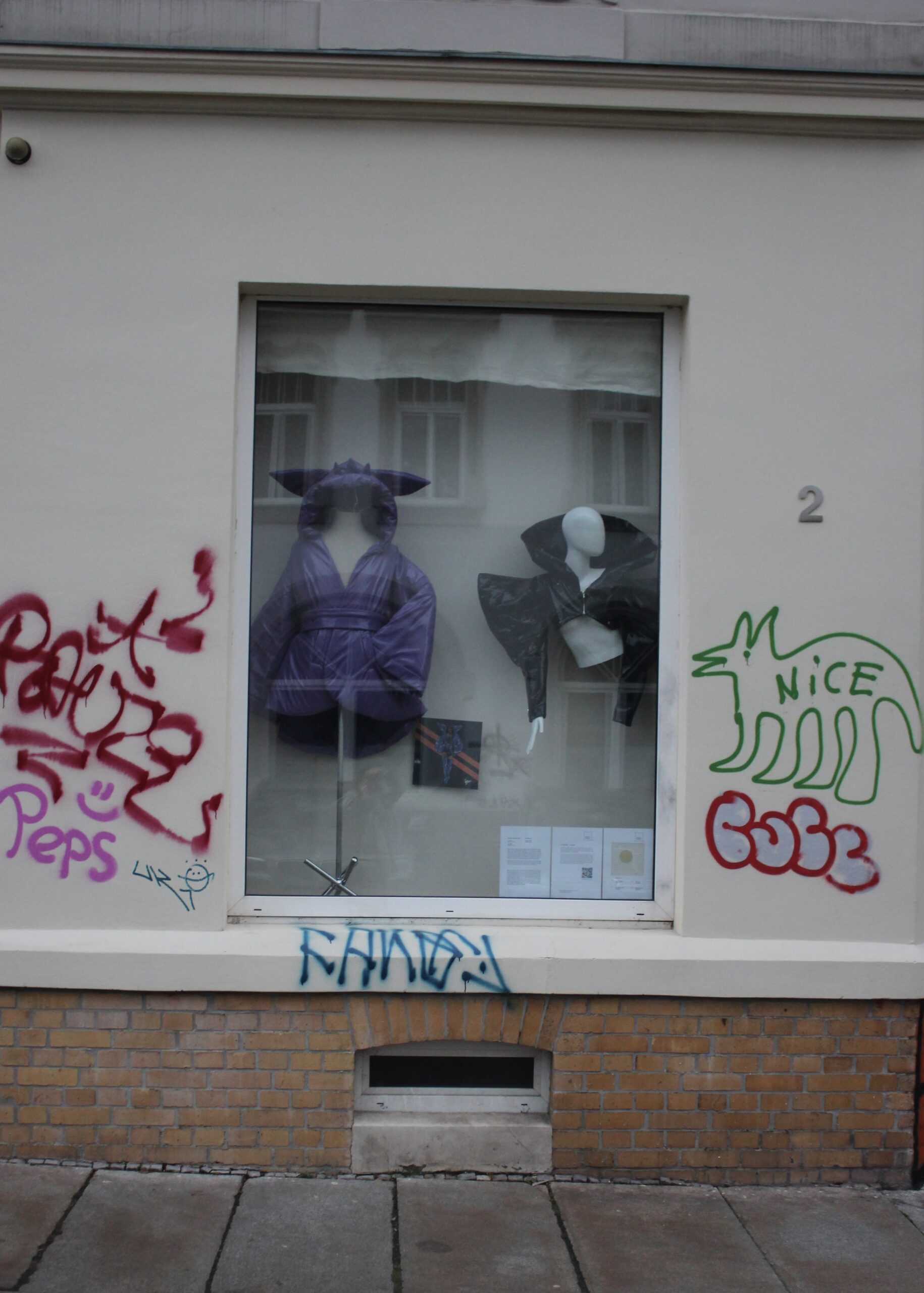
Veronika Weber
Sternenschaukel, 2019
mixed technique
Veronika Weber's Sternenschaukel fascinates with elements of both romance and childishness alike. The title of the work makes viewers dream of the glittering expanse of infinity - the swing is widely known as a symbol of lightness and infantile happiness.
In addition to the function of the swing alluded to in the title, the object has another function: it visually represents an oversized headlamp, which is usually indispensable for moving around in nature at night. In addition to the shape of the lamp, the colourful nylon strap in particular conveys the reference to outdoor equipment.
With this work, the artist refers to the ambivalence present in the commodification of a romantic idea of nature. A (purchasable) object made of plastic seems to be the key to happiness: a swing that allows floating in the open air and at the same time illuminates the way into the night, as an immediate access to nature.
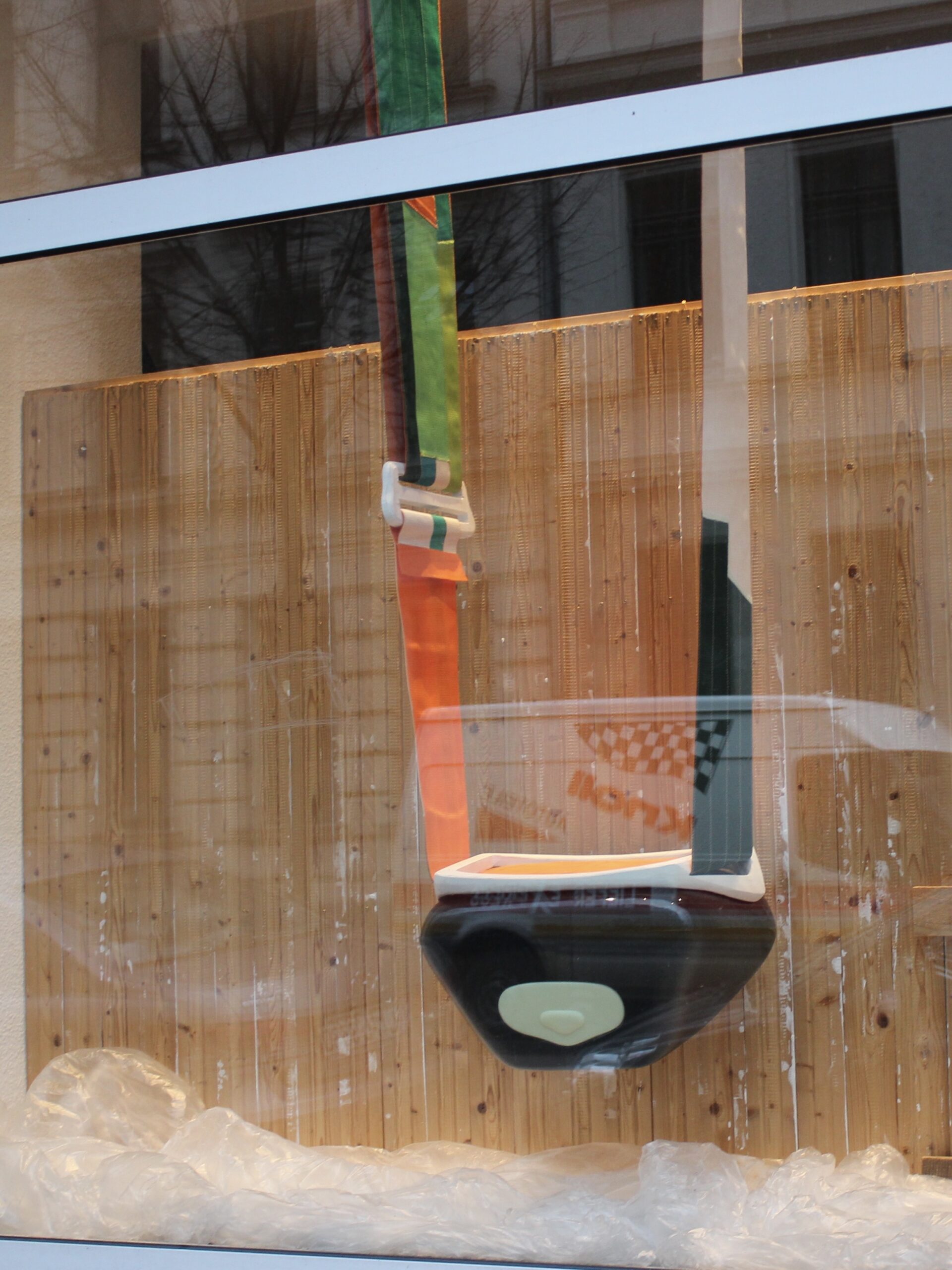
Antonia Kemper
Martian Tails, 2018
polyester, acetate
Antonia Kemper's coat also pursues a clear protective function, being in essence an object of reflection that tries to protect the wearer from various dangers. The Martian Tailcoat was designed to be worn on Mars. In order to be able to defy the adverse conditions on site, the artist relies on exaggeration. It is too heavily padded, too long, too reflective. The classic elements of the garment are clearly recognisable, but abstracted and altered. The reflective fabric reflects the dreamlike and unreal - its colours, which are created by reflections and therefore exist in a constant state of flux, are hardly really comprehensible.
The (show) window seems therefore to be an in-between - a venue for both the public in private and the private in public.

Rike Droescher
My heart beats in my breat (no fear), 2021
glazed ceramic, elastic cord
My heart beats in my breat (fast rider), 2021
glazed ceramic, elastic cord
What do we reveal of our private, intimate space?
What do we bring into the public space?
Which protective spaces are preserved?
Is the window itself interior or exterior space - private or public?
Is it a space where one is protected from the environment, or where one must protect oneself?
To what extent does the window provide an insight into private space?
And what do we see when we look outside?
The artist Rike Droescher plays with this uncertainty of space. Clothes are often carelessly thrown on the floor in one's own home. The textile structure is not impressed by this action. Rike Droescher's "statement" shirts from the work My Heart Beats in My Breast were cast in ceramic and thus lose their textile properties. By changing their materiality, they have become vulnerable, if you will. Slogans and inscriptions, such as "Fast Rider. Burnout Lane", point to capitalist self-exploitation and pick up on the pressure to continuously prove one's identity, optimisation and efficiency.
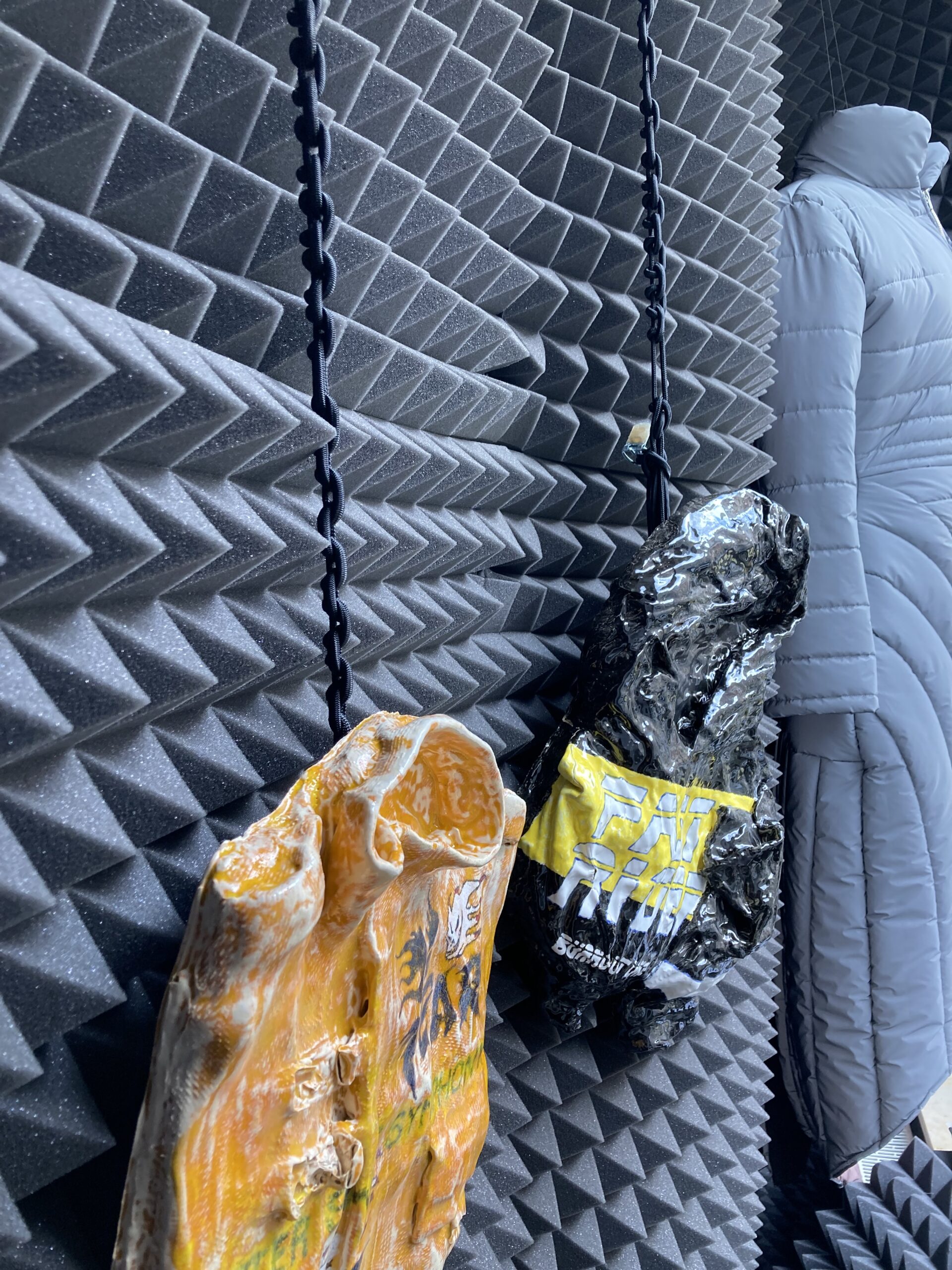
September 2021 - January 2022
Helena Hafemann
restoration (series), 2020
porcelain, yarn
The basis is not a standard IKEA plate that is broken, almost used up, after many times of service. Rather, it is a porcelain that in all likelihood was only allowed to decorate the table on special occasions and has nevertheless broken due to its fragility. In her work Restoration (Series), Helena Hafemann does not attempt to inconspicuously repair and preserve the cherished object. Rather, she deliberately reveals the signs of age. The artist takes the colours present in the plate and visually enlarges the fracture. It almost seems as if the paint is running out. Instead of gluing the plate and continuing to use it in everyday life, she emphasises its special position and puts it on display: No longer on the table, but on the wall. The threads are not connected to form a fabric, serving rather to highlight the fragility of the object and with them a work of art is created from the utilitarian object.
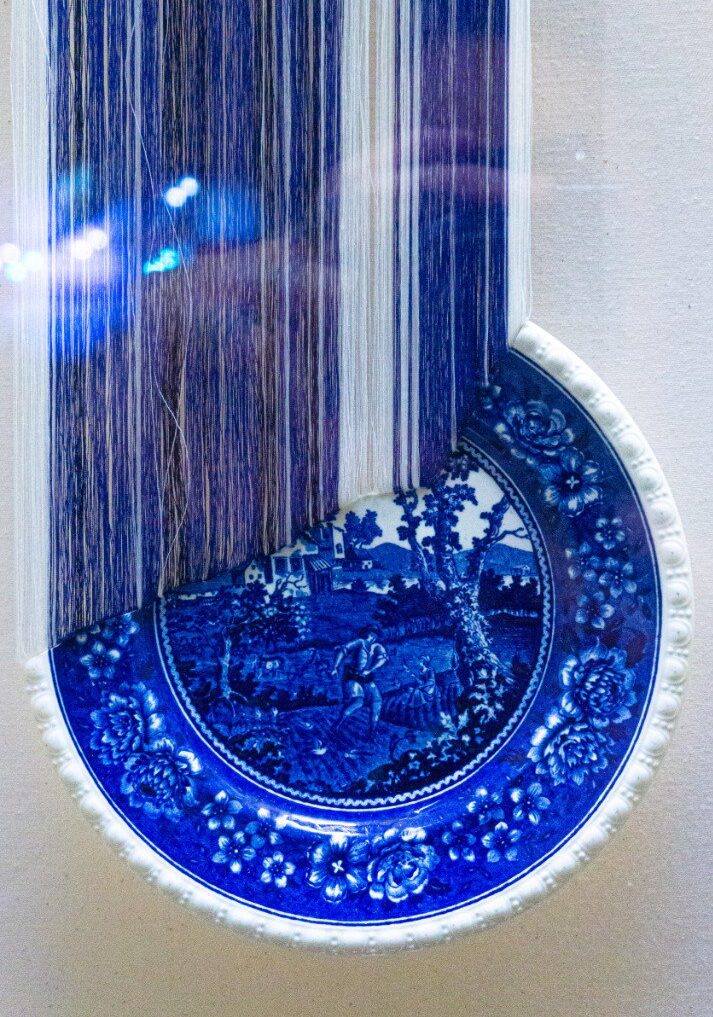
Paula Holzhauser
Fridays You Eat Fish
wire, fishing line, polyester
| Paula Holzhauser's work 'Fridays You Eat Fish' is also dedicated to everyday life on the dining table - specifically the inside of a sardine can. The artist is particularly concerned with the haptic effect of textiles. Textiles are usually first associated with warmth and softness, but not with the moist and cold surface of a dead fish. After a thorough colour analysis, Paula Holzhauser selects various yarns, which she then knits into fabrics to create a deceptively realistic replica of fish skin. She breaks with the viewer's perceptual habits, presenting the textile materiality of the work only at second glance. |
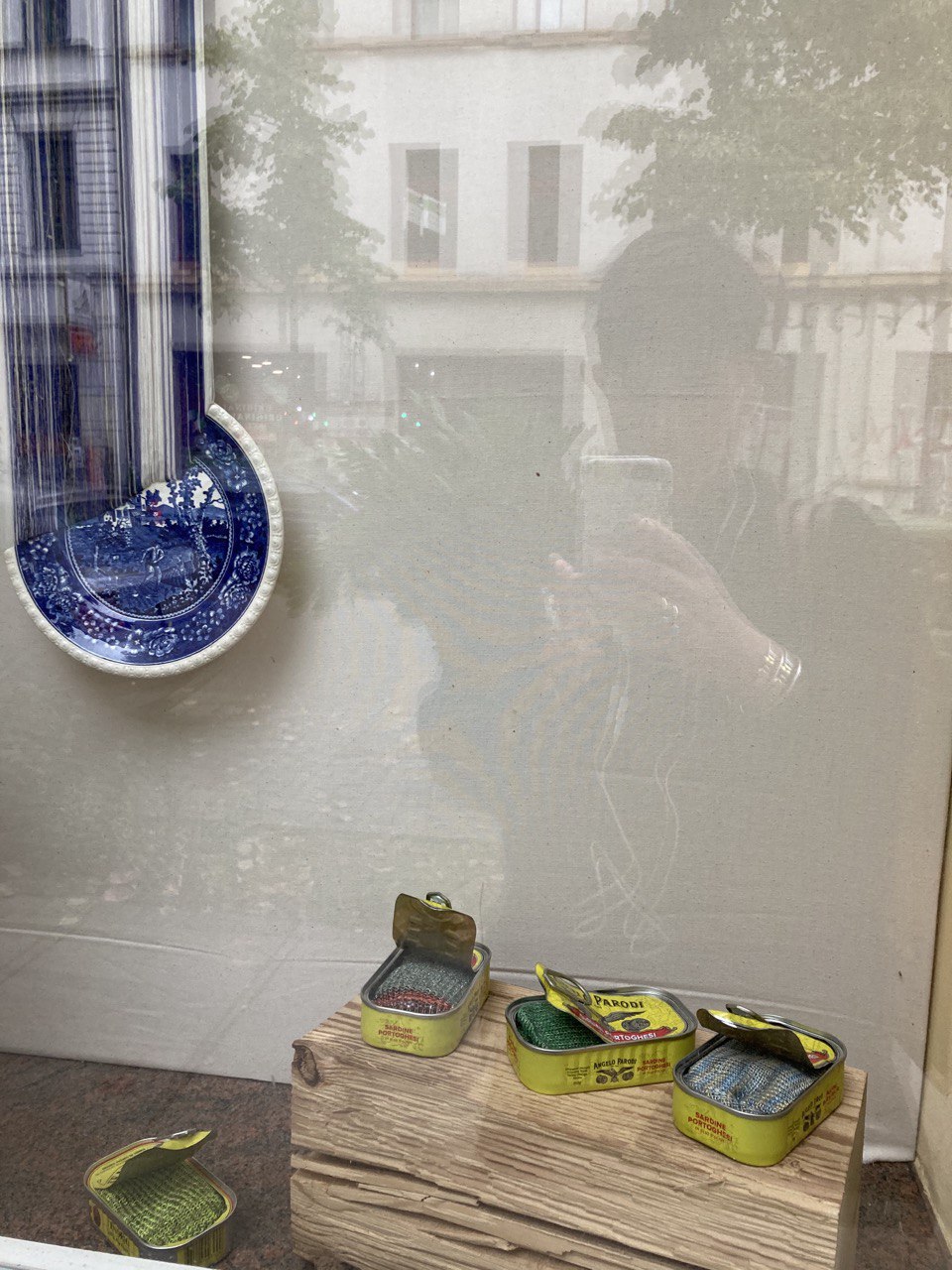
Lili Anschütz
Manifeste du Rio Negro, 2021
textile printing on voile (cotton)
During her research on forests as historical and contemporary habitats, the set designer Lili Anschütz intensively studied the Manifeste du Rio Negro (1978) by the French art critic Pierre Restany, which was created during a trip to Brazil and with the collaboration of the artists Frans Krajcberg and Sepp Baendereck. The view of nature at that time and the artistic confrontation with it led Lili Anschütz to extend her research on forests to questions of primordial plant forms. In the experimental work shown here, she lets (ancient) trees grow horizontally in abstracted form on the slightly transparent fabric and gives them a slight optical movement through the flowing material quality of the voile. The intense colours make this fabric very easy to imagine in the context of even a large stage set.
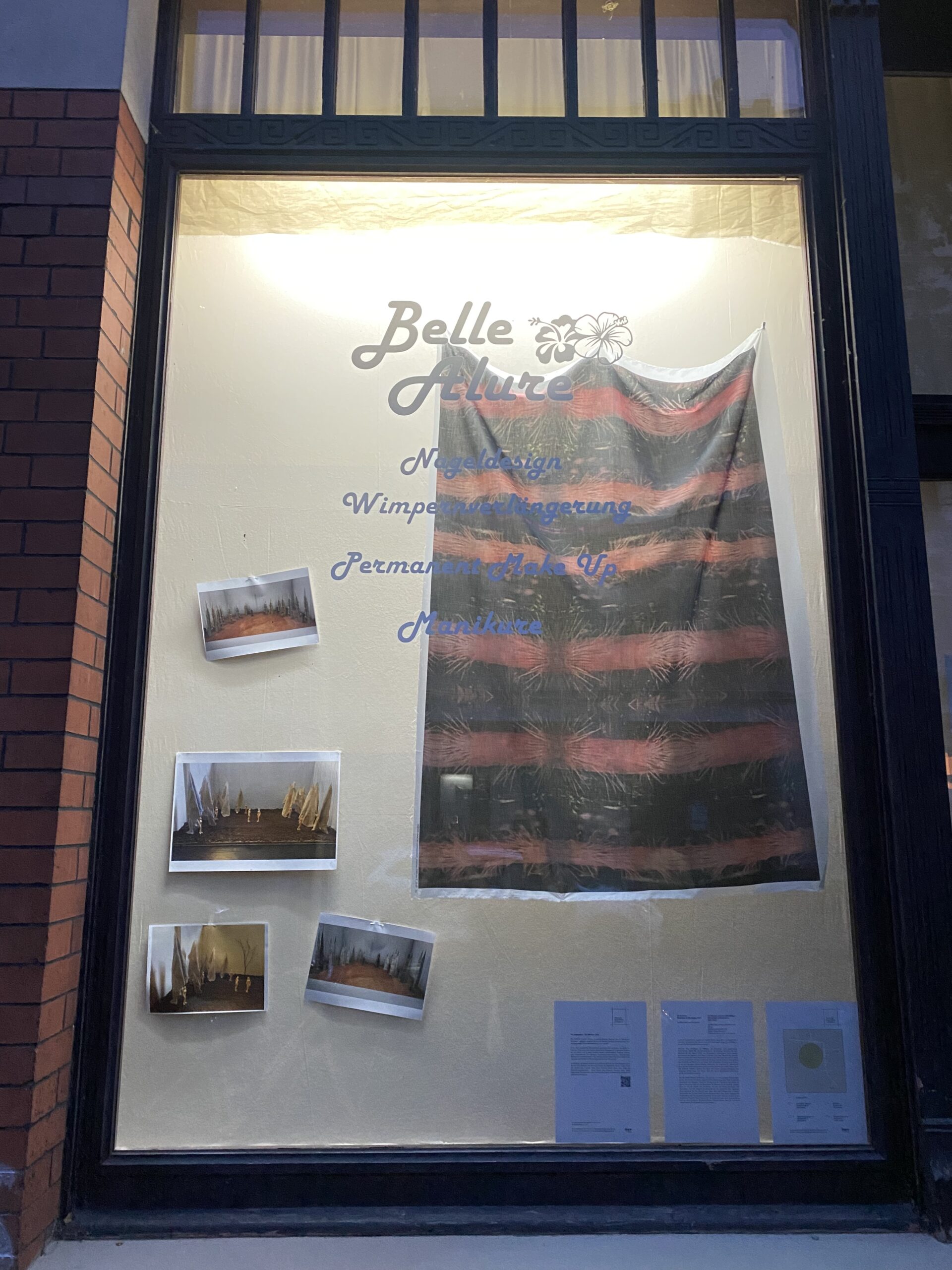
Kat Válastur und Leon Eixenberger
stage design for Diana Even, 2021/2022
| Strips of fabric hanging from the ceiling create folds on the earth-covered floor. They are reminiscent of trees and their arrangement creates a forest in which the dancers move. However, the surface of the fabric is sealed by wax, which triggers not only an association with a canopy of branches, but also the idea of animal skins hanging from the ceiling. Four dancers and four singers reinterpret the story of Diana (Artemis), the goddess of the hunt, who is spotted by Aktaion, the hunter, while bathing, in this stage design. In the piece, nudist bathing, hunting, being hunted, transformation and death are danced through and translated into a wider context of our present. In the process, the viewers can become aware of their own gaze and the power relationship it preserves as they gaze in an almost voyeuristic manner at naked dancers. Assistant stage design: Cecilia Nercasseau Gibson Model: Matteo Marangoni Opening night in January 2022 at HAU, Berlin |

Anna Greckl
Plexus Solaris, 2020/2021
cyanotype on cotton fabric
In Anna Greckl's work, the textile medium becomes the carrier of unusual photographic images. Using the cyanotype technique, the fabric is first made light-sensitive by chemicals and then later exposed to daylight. In this photogrammatic work, the artist's body, which partially covers the textile surface in various poses and thus protects it from the incident light, is brightly reproduced on the textile. In everyday life, textiles in the form of clothing are used specifically to have an influence on the human body and to convey messages. They serve to protect, form and present the body or certain messages. Anna Greckl mirrors this concept: her body influences the fabric, defines the pattern and gives the fabric a certain shape. This image of her body on the fabric is not only a spatial but also a temporal one. Even on sunny days, the exposure of the surface can take at least 7-20 minutes, this time to remain motionless in the postures is impossible. Shadows, overlaps and expansions of the body image show the artist's movement and fix the time of exposure.
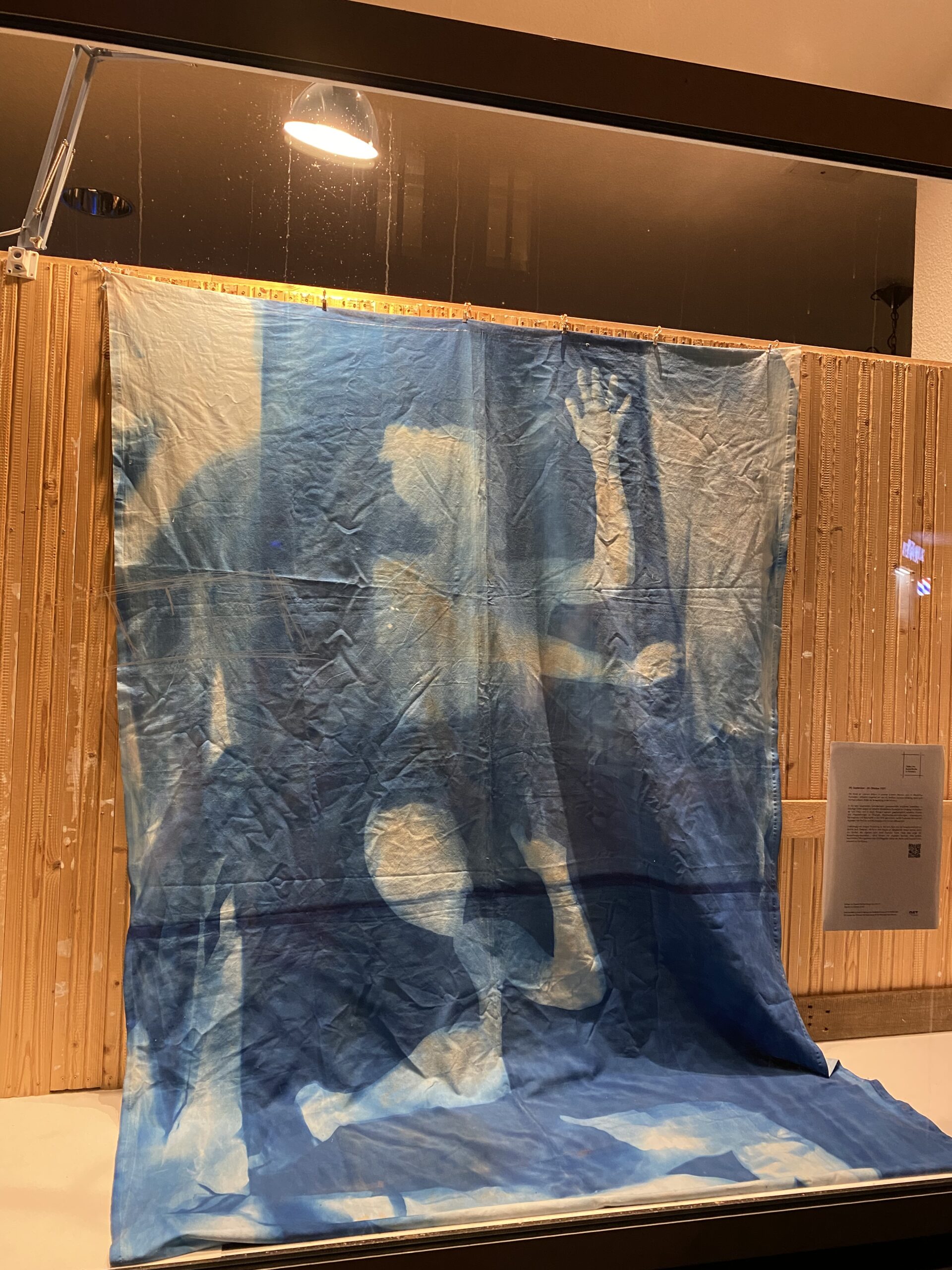
Vanessa Josefine Lurtz
Don’t Collapse, 2019
lycra jersey screen-printed with thermo-active pigments
In the collection Don't Collapse, Vanessa Josefine Lurtz deconstructs attitudes to female bodies and physical conditions. The artist juxtaposes the feeling of weakness and insignificance often felt by women with powerful elements from nature, without negating the shapes of the bodies. Elastic jersey fabric nestles around the human body. The ochre colour and the structure created by the screen-printing process with thermoactive pigments give the dress the appearance of the rough bark of a tree trunk that rises straight up, sturdily rooted.
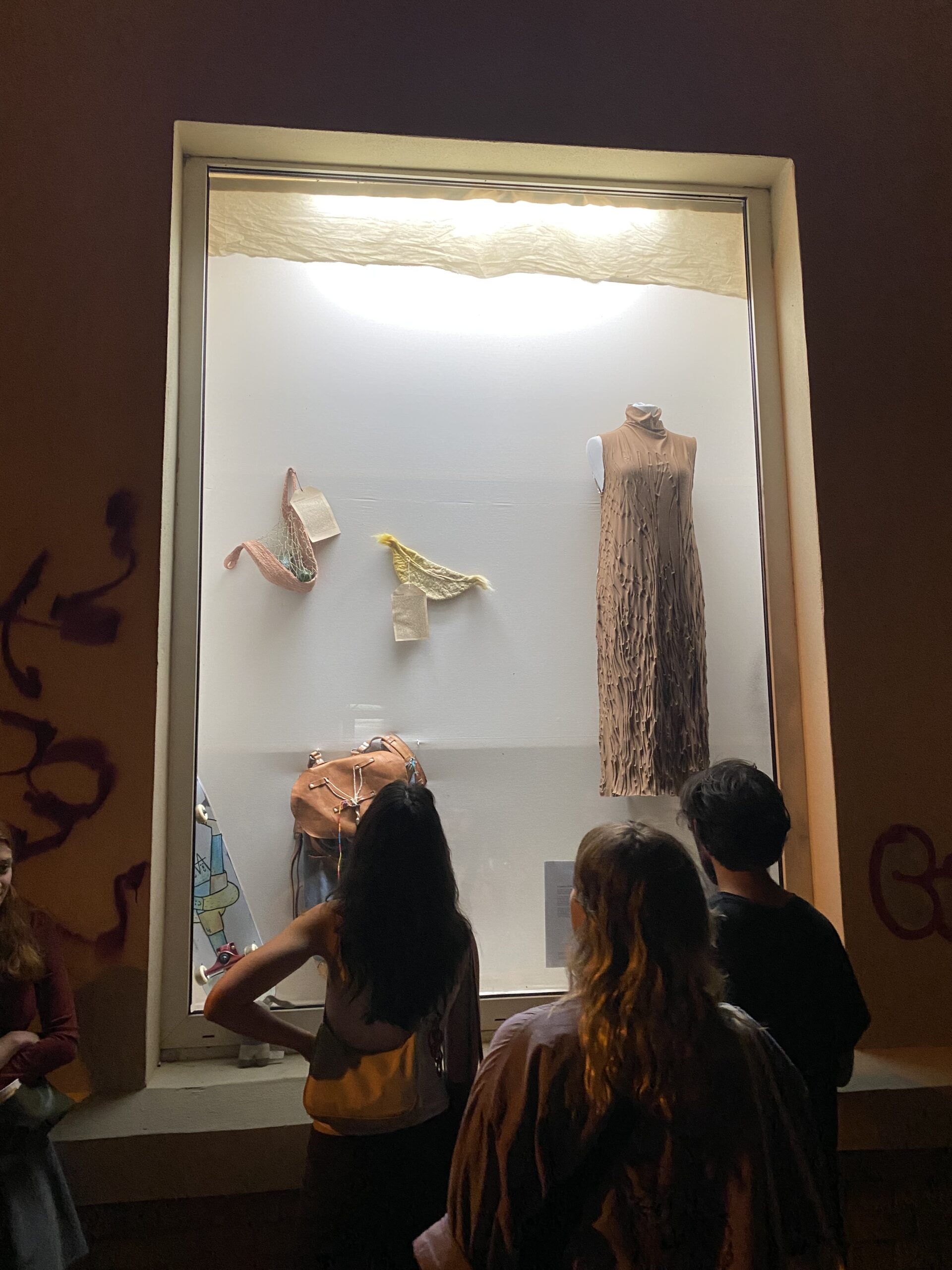
Meike Schmitz
Avocado bag
linen yarn dyed with green earth, jute dyed with avocado
Bananas fanny pack
banana fiber with silk yarn dyed with turmeric and nettle
| In her project 'mindful packaging', artist Meike Schmitz explores the cultivation, ripeness, transport and trade of luxury foods such as exotic fruits. We are not always aware of the distant origins of the fruits we see in the supermarkets every day, and we often know even less about their cultivation and transport. Schmitz processes this knowledge in bags made especially for the respective fruits. For the avocado bag, the artist sews together jute strings that she has previously dyed with avocado and ties a net of linen yarn dyed with green earth between them. With this craftsmanship, Schmitz indirectly refers to water privatisation and the media images of the juxtaposition of areas of parched earth and artificially created fertile plantations. The Banana Belly Bag is made of banana fibres, which the artist lays on top of each other and binds with silk yarn. After the bag is made up, it is dyed with turmeric and stinging nettles, giving it a colour gradient that indicates the ripeness of the banana: green when they arrive in their country of import, they are sprayed with a ripening gas before eventually turning yellow in the supermarket. |
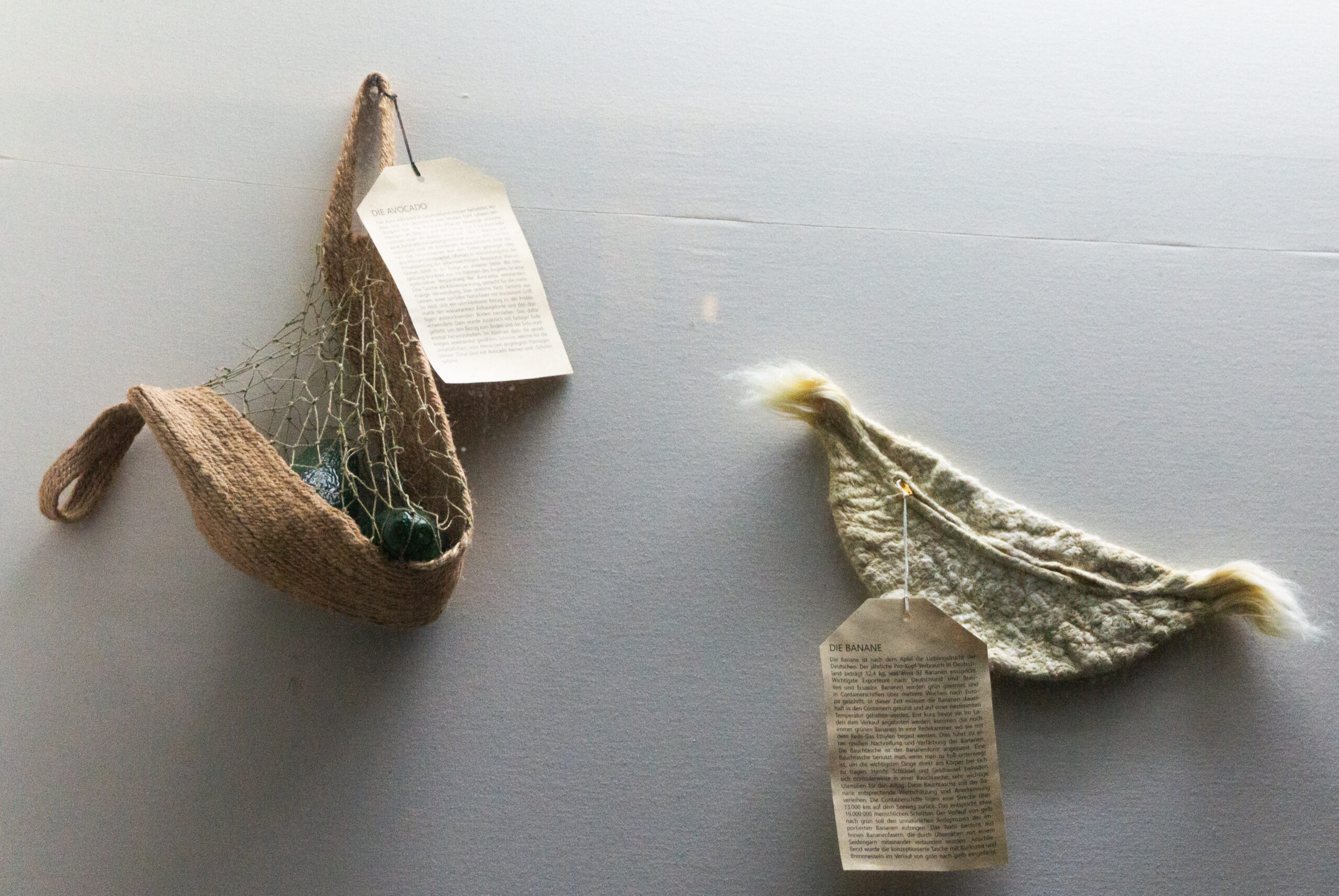
Leon Schoofs
Duffel bag, 2018
calf leather (greased), canvas (waxed)
In a world where products are becoming cheaper and cheaper and are designed to be short-lived, Leon Schoofs is developing a modular counter-model to short-term consumption and, ergo, a material basis for sustainable travel. The wish: a backpack, a bag that can be repaired independently in all situations and potentially lasts forever. The selection of possible components he has come across on his search: a mishmash of synthetic composites, whose individual parts have to be replaced and disposed of in the event of a defect. His duffel bag offers an alternative that is as functional as it is sustainable, thanks to the durable materials that can be sewn and replaced. A skateboard holder allows it to be attached to and pulled on a skateboard when carrying a heavy load. At the same time, the skateboard as a form of transport enables a self-sufficient and ecological journey.
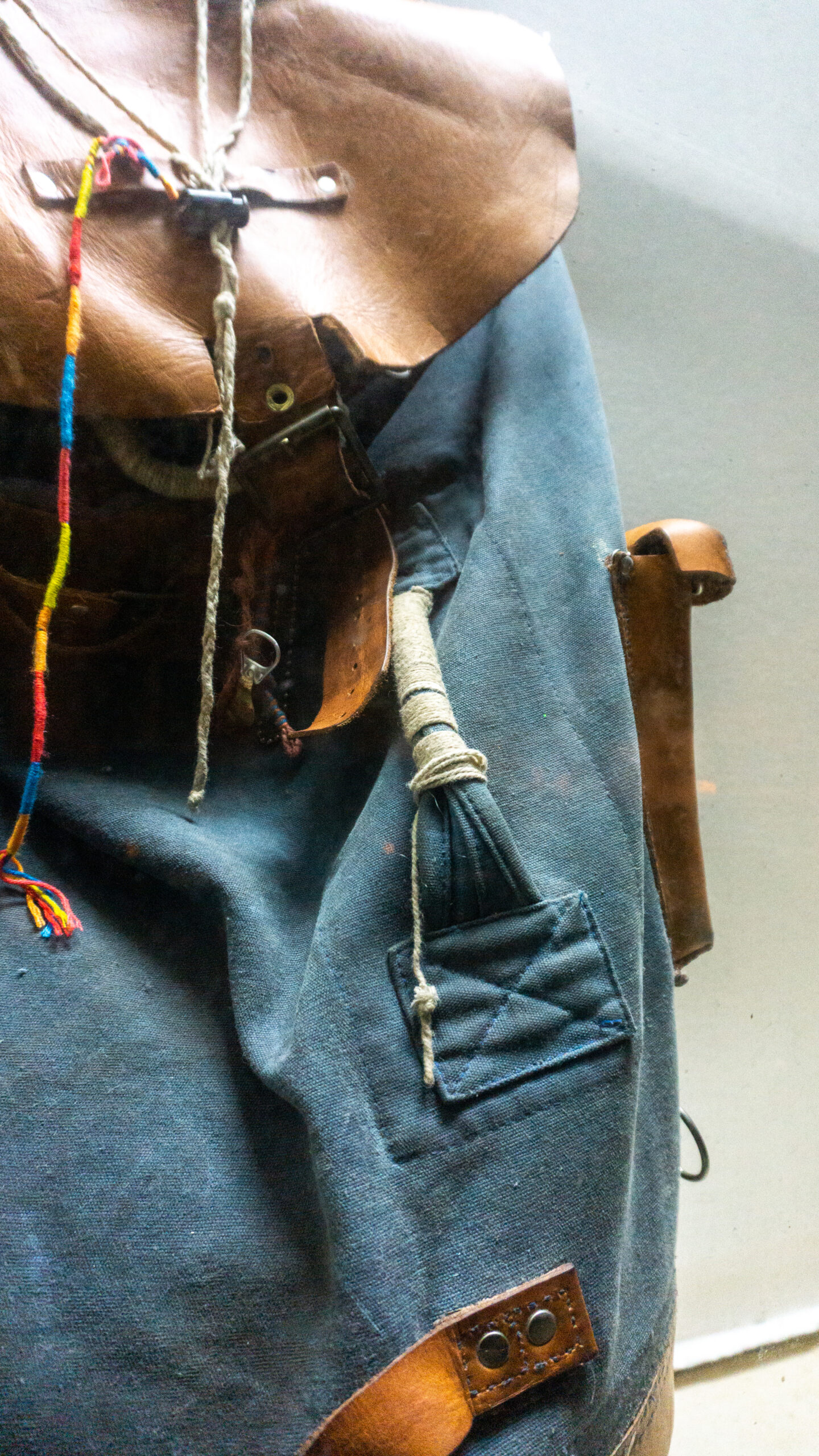
Ýrúrarí
Hljómsveitt, o.J.
The Hljómsveitt jumpers were created in cooperation with the rap duo Hljómsveitt. The two musicians sing about feminism and free, uninhibited sexuality. At the centre of the works is the female body, which is presented and celebrated in a way that does not correspond to the hairless mainstream beauty ideals of the advertising and fashion industry. By means of craft textile processing techniques (embroidery and knitting), which still have feminine connotations today, Ýrúrarí questions female body ideals.
Foto: Antonía Lárusdóttir Hljómsveitt: Katrín Helga Andrésdóttir and Anna Tara Andrésdóttir

Cordula Schieri
I Arthandle You, 2020
west for "messy history lesson" in the production of Caroline Kapp
| Cordula Schieri deals with gender-specific attributions in the professional environment. In the male dominated technical museum sector, she works exclusively with male colleagues. With her interpretation of technical drawings, she draws attention to the orientation and design of tools and aids, which are often oriented towards male bodies. The artist has some of the drawings printed on what appears to be quilted fabric. The use of colour, as well as the cut and material of the waistcoats sewn from this fabric, creates a tension between the light-looking lilac base fabric printed in shades of pink and the rough buckles on the garments, reminiscent of work waistcoats. |

Tex Rubinowitz
Stickstoffe
fabric remnants, disposed textiles, yarn, colour
Tex Rubinwoitz, known for his caricatures and texts, devotes his new series of works to aspects of the textile. From fabric remnants, discarded home textiles and colored yarn and paint he creates so-called embroidery fabrics. Humorous, enigmatic, meaningless and also very meaningful thoughts, mock proverbs and snippets of thoughts, the artist paints and embroiders on sewn-together fabrics. With multiple stitches, the artist creates different thicknesses of writing, which are supported by the applied dyes. Upper and lower threads remain unsewn and tangled on the letters and their ends, extending the typeface into space. The seemingly quickly handwritten words, which formulate short statements and requests, are reminiscent of banners and in their composition of relics of various demonstrations.
